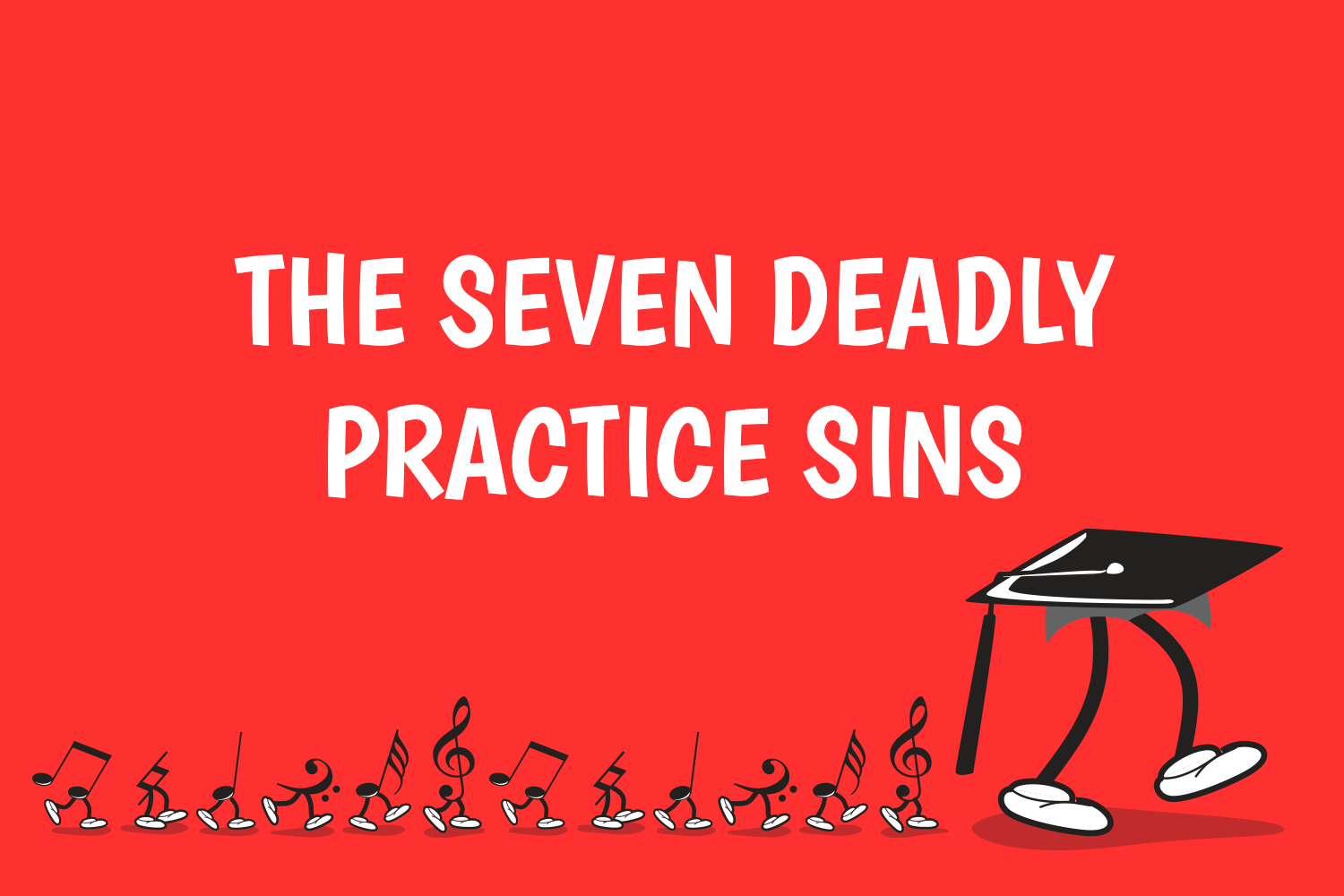The Seven Deadly Practice Sins

Children get so much out of learning a musical instrument, both academically and socially. Having piano lessons is a joy. However, the practice that needs to take place between lessons can often be a stumbling block on the road to success. The following ‘Seven Deadly Sins’ of practice are mainly to do with piano practice, but the information given can be applied to any instrument.
1. No routine
The average child does not naturally gravitate towards piano practice (or practice on any instrument!) at home. This is completely normal – just like they don’t naturally gravitate towards doing homework. There is no point waiting for the magical time when a child will ‘feel’ like practising. Practice needs to be timetabled in, and it should be a compulsory part of the daily/weekly routine, like brushing teeth. If a child senses that practising is optional, most times they will opt out.
A reasonable practice routine would consist of at least four practices per week. This means that practice is at least taking place on more days than it is not! Five sessions per week is ideal, and any more than that… well, the teacher will be in heaven. As for how long the practice should be, that all depends on the level of piano, the age of the child, and the efficiency of the practice! Ten minutes of really solid practice is more effective than thirty minutes of just playing through pieces without listening or fixing. The key is to have a consistent time each day for practice to take place, for example Monday at 4, Wednesday at 7:30, Thursday at 4, Saturday at 9, and so on.
2. Too isolated
If the piano is tucked away in a room at the back of the house so that the noise won’t disturb anyone, this can make it a very solitary and unappealing activity for the child. Sometimes the piano or keyboard is kept in the child’s bedroom, which can also be isolating and can be a deterrent to practice – often there are too many tempting distractions in the bedroom. The best location for practice to take place is in a family room, or near the kitchen, where there tends to be a hub of activity and where a parent can keep track of what is (and is not) being done.
3. Inadequate instrument
This can be a tricky one. Not every young pianist’s family can afford an acoustic piano, either in terms of money or space in the house. A digital keyboard is absolutely fine and there are many fine instruments on the market. Many families make a small initial investment in a half-size keyboard, rather than spending a lot of money only to find that the child loses interest in playing after a term or so.
A small keyboard is fine for the first few months but after a while it will be fairly limiting in what it can produce, and the child may be less enthusiastic to practise on it. Another thing to consider is that small keyboards do not usually have weighted keys and this is not great for learning piano technique. The difficulty for parents in this situation is that the child appears to have lost interest, so why invest in another instrument… but often it is exactly that investment that will re-ignite the child’s enthusiasm!
4. No Availability
Is there actually enough time in the child’s week to learn a musical instrument? A really useful thing to do is to sit down with your child and write down his/her weekly timetable. Then decide which days and times the practice will take place. (Deciding on this together will greatly increase the chances that the routine will be followed!) There should be AT LEAST four opportunities during the week to do some practice. If a students’ week is so full of extra-curricular activities that you can’t fit in four practice sessions, this will certainly influence the rate of progress on their instrument.
5. No Structure
Practising means getting a piece to sound better at the end of the practice than it did at the beginning. Simply playing a piece through from beginning to end does not necessarily improve the way it sounds. Most children need to be taught how to practice – it’s not a skill that comes naturally. The teacher is the best person to give tips on this, but here are some useful practise strategies to get you going:
· Start with the hardest or newest pieces. Leave the more familiar pieces until the end.
· When fixing a certain passage, get it right 3 times IN A ROW before moving on.
· When attempting something hands together for the first time, try it at about half the speed you can do it hands separately.
6. No goals
For most children, there needs to be some point to practising. Whereas adults get a lot of intrinsic value from working hard and achieving something, children actually need EXTRINSIC value – that is, doing well in a performance or exam, receiving praise from an adult, or even just learning a certain amount of pieces per term and earning a tick on a chart for each.
Whilst music exams can be great goals to focus on, they don’t necessarily suit every child, and can sometimes end up being a very stressful experience. A concert for family and friends is often the best and most enjoyable goal for children to work towards. Inviting the rellies over for afternoon tea and playing a few pieces for them is a wonderful way to spend a Sunday afternoon.
7. No support
Don’t mistake a lack of motivation to practice for a lack of wanting to play a musical instrument.
Many parents despair that their children won’t practice and what a shame it is that they simply don’t want to learn piano. The fact is that most children will baulk at practice when the time comes around, but it just takes a little cajoling from the parents (see Deadly Sin nos. 1 and 4) and the practice session usually goes just fine. As a teacher and parent myself I have had countless adults say to me “I wish my parents hadn’t let me give up piano!” I have never heard anyone say, “I wish my parents hadn’t made me keep going even when I wanted to give up. I can still play today and it’s really annoying!” There is much joy to be had from learning and playing piano and it is really up to us as parents to see the ‘big picture’ and support our children through those times when they are feeling negative about practice.
Once again, the most important thing for parents to remember is this: just because a child doesn’t want to practice, it doesn’t mean they don’t want to play a musical instrument.
